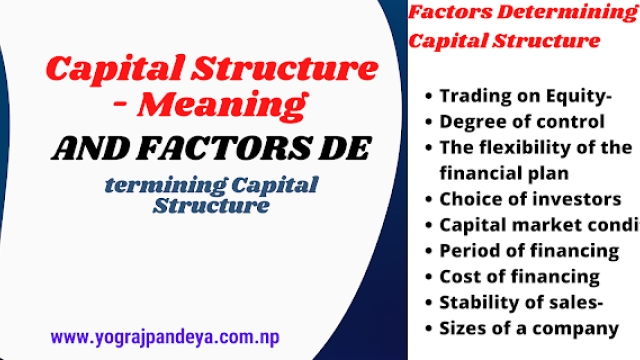Capital Structure – Meaning and Factors Determining Capital Structure
The ratio of different types of securities raised by a company as long-term funding is referred to as capital structure. The capital structure is determined by two factors:
a. The type of securities to be issued, such as equity shares, preference shares, and long-term borrowings (Debentures).
b. The capital gearing technique can be used to determine the relative ratio of securities. The businesses are classified into two categories based on this.
- Highly geared corporations are those with a tiny fraction of their stock capitalization.
- Low-geared corporations are those whose equity capital is more than their entire capitalization.
For example, let’s say there are two companies, A and B. In each example, the total capitalization is USD 200,000. Company A has a USD 50,000 equity capital-to-total-capitalization ratio, while company B has a USD 150,000 equity capital-to-total-capitalization ratio, i.e., Company A has a 25% equity capital-to-total-capitalization ratio and Company B has a 75% equity capital-to-total-capitalization ratio. Company A is a highly geared company in this scenario, while company B is a low geared company.
Factors Determining Capital Structure
1. Trading on Equity-
The term “equity” refers to a company’s ownership. Taking advantage of equity share capital to borrow funds on a reasonable basis is referred to as trading on equity. It refers to earnings that equity owners receive as a result of the issue of debentures and preference shares.
It is based on the idea that equity shareholders benefit when the rate of dividend on preference capital and the rate of interest on borrowed capital is lower than the general rate of company earnings, which means a company should use a judicious mix of preference shares, equity shares, and debentures. When shareholders’ expectations are high, equity trading becomes more essential.
2. Degree of control-
The directors are the so-called elected representatives of equity shareholders in a corporation. In comparison to preferred shareholders and debt holders, these members have the most voting power in a company. Preference shareholders have fewer voting rights than debenture holders, who have none at all. The capital structure consists of debenture holders and loans rather than equity shares if the company’s management practices are such that they desire to keep their voting rights in their hands.
3. Financial plan flexibility-
In an enterprise, the capital structure should allow for both contractions and relaxations in plans. Debentures and loans can be repaid whenever the need arises. While stock capital cannot be repaid at any time, plans are more rigorous. As a result, the corporation should issue debentures and other loans to complete the capital structure.
4. Investor selection—
In general, the company’s policy is to have distinct types of investors for securities. As a result, a capital structure should provide ample investment options for all types of investors. Equity shares and loans are popular among bold and adventurous investors, whereas debentures are popular among cautious investors.
5. Capital market conditions-
Throughout the company’s existence, the market price of its shares has had a significant impact. During the Great Depression, a company’s capital structure was often made up of debentures and loans. During booms and inflation, the company’s capital should be made up of share capital, or equity shares.
6. Financing time-
When a firm needs funds for a short period, it seeks loans from banks and other institutions; when it needs funds for a longer period, it issues shares and debentures.
7. Cost of financing-
When raising securities in a capital structure, the corporation must consider the cost component. It has been observed that debentures are a less expensive source of finance throughout a company’s profit-making period than equity shares, which demand an additional share of profits.
8. Sales stability-
A well-established company with a developing market and large sales turnover is in a position to meet fixed commitments. Debenture interest must be paid regardless of profit.
As a result, when sales are strong, profits are high, and the company is in a better position to satisfy fixed commitments like debt interest and preference share dividends. If a company’s revenues are inconsistent, it will be unable to meet its fixed obligations. As a result, equity capital proves to be safe in these situations.
9. Company sizes-
The capital structure of small businesses is often made up of bank loans and retained profits. Big enterprises, on the other hand, with a solid reputation, stability, and proven profit can easily issue shares and debentures, as well as take out loans and borrowings from financial institutions. The wider the total capitalization, the larger the size.
- Financial Management – Meaning, Objectives, and Functions
- Human Resource Management System
- Market Information System (MIS) and Components
- Importance/Role of marketing
- E-marketing (internet marketing/ E-commerce)
- Concept of learning
- Introduction to Capital Structure Theories
- The Role of the Finance Function in Organizational Processes


